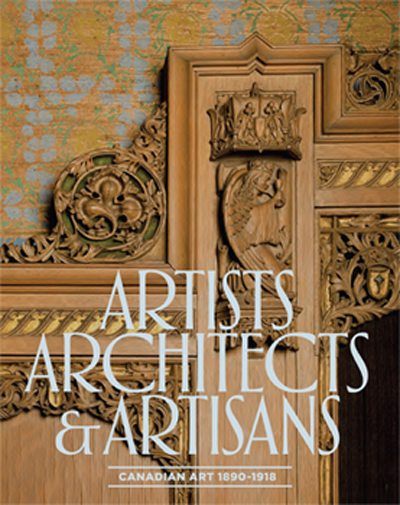
By Ann Marie Holland
The National Gallery of Canada describes its most recent show entitled Artists, Architects and Artisans: Canadian Art 1890-1918 as a “look at the interaction among artists, architects and artisans, as well as critics and collectors at the turn of the 20th century.” This national exhibition has received high praise from critics and the general public alike but did you know that the McGill Library was the single most important lender to the show? The Library contributed over 75 pieces for loan – everything from rough art sketches to presentation watercolours to hand-drawn architectural designs, not to mention the fabric samples, the bronze bust, the chairs and a sculpted wood cabinet – all of it from McGill’s Rare & Special Collections.
How long does it take to put something this extensive together? McGill’s involvement began in 2009 when Chief Curator of the exhibition, Charles C. Hill and a large team of co-curators, investigated the holdings of many Canadian archival and architectural repositories, including McGill’s John Bland Canadian Architecture Collection (CAC). At the time, Hill was looking for architectural projects that illustrated, “the aesthetic of the Beaux-Arts tradition and the Arts and Crafts movement, enhanced by many international currents of art.”
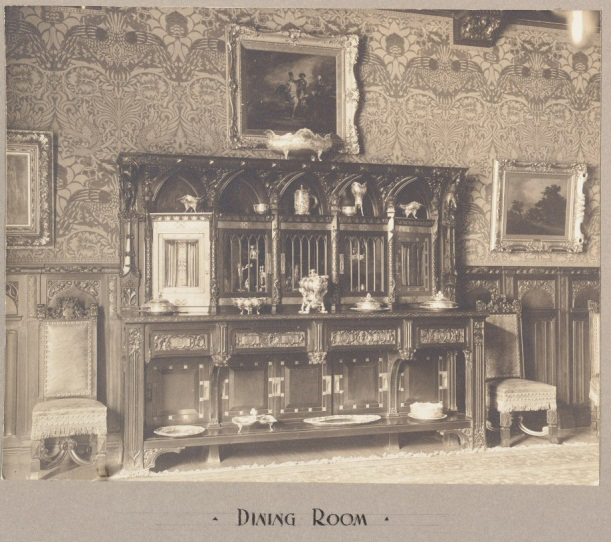
Hill, along with, Rosalind Pepall, a contributing associate based in Montreal and former Senior Curator of Decorative Arts at the Montreal Museum of Fine Arts, examined with well-trained eyes, several hundred architectural drawings in minute detail. They also sorted through archival material such as logbooks, diaries, photo albums, supply catalogues, project cost ledgers, looking for signatures with which to trace and identify collaborative connections between artists, architects, artisans, landscape designers and urban planners.
They were not disappointed by what they found. They drew heavily from the McGill Library’s rare and special materials within the architectural archives of the Maxwell Brothers and Percy Nobbs housed in the John Bland Canadian Architecture Collection. “Thank heaven John Bland recognized the importance of the Maxwell and Nobbs fonds and preserved them,” says Hill. “Without these resources it would have been incredibly difficult to organize the exhibition. Not only were these two firms immensely important but the range of material held at the John Bland Canadian perfectly exemplifies our thesis.”
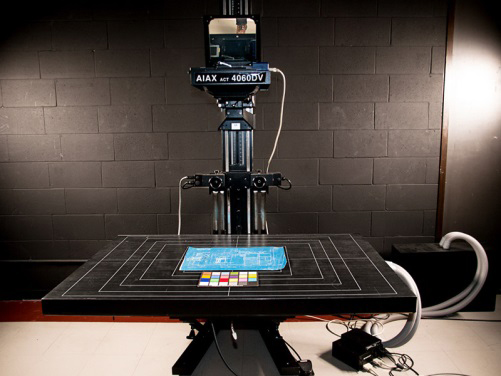
In addition, over a two-year period, from 2011 to 2013, more than 100 photographs were selected by the curatorial team for the digital component of the exhibit. In particular, these images were intended for monitors to be placed in strategic locations of the exhibit space. Digitised images were also displayed on the exhibit’s microsite and in the published catalogue. A substantial number of these illustrations were produced by high-performance overhead scanners operated and managed by the library’s Digital Initiatives staff members Greg Houston and Jennifer Innes.
What comes next is the least obvious aspect of exhibition creation to the general public. The project management side began in earnest under the supervision of Nelda Damiano, Senior Project Manager, Exhibitions Management from the National Gallery of Canada (NGC). My contact with the gamut of experts from the NGC was extremely positive. Collaboration is the key word when describing this project. Partnerships are not only a key subject of the exhibition but the cooperative interactions between practitioners were amply demonstrated behind the scenes as well in the preparation of the show.
One of our tasks in Rare Books & Special Collections was to hire an external evaluator, in this case, Richard Gingras of Montreal. Gingras specializes in the appraisal of architectural drawings in order to attribute a market value to each item for insurance purposes. The high spot of our evaluation was the bust of William McLennan by Louis-Philippe Hébert.
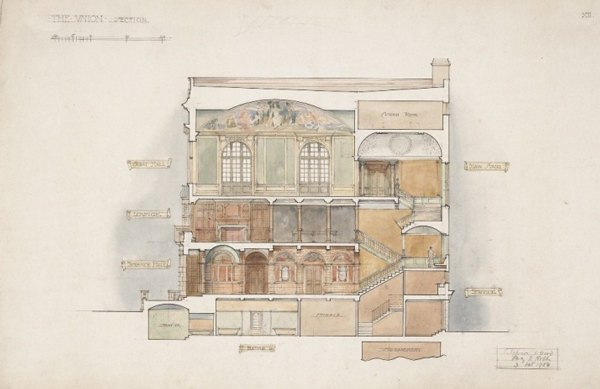
Once the materials were assessed, restoration and conservation staff members from the NGC visited the John Bland Canadian Architecture Collection in January to approve the selected materials for transportation to Ottawa. Over the next several weeks, NGC Conservator of Prints and Drawings, Ainsley Walton, and her colleagues recommended treatment proposals for surface cleaning or repairs to the works on paper or to the photographs, all of which was achieved in their own conservation spaces at the NGC. To the Library’s delight, serious time was devoted to determining the original covering of a Nobbs lounge chair that they intended to restore. In the end, it was discovered to be made of black horsehair.
And if you were wondering how one packs extra-large flat drawings that are sometimes on flimsy linen or on thin tracing paper – the answer is with the utmost care. In fact, the Transit Coordinator from the NGC sent three of their art handlers to collect the 76 items to be loaned – 59 works on paper, 12 photos, 1 bronze, 1 plaster, 2 chairs, and 1 cabinet to be exact. The large drawings, for instance, were separated into three sizes, interleaved, compacted and sealed between boards and carried out of the premises by the NGC specialists, right side up, to the art transport vehicle parked right outside on McTavish Street. That pick-up occurred in February 2013, leaving just enough time to prepare for the opening in November 2013.
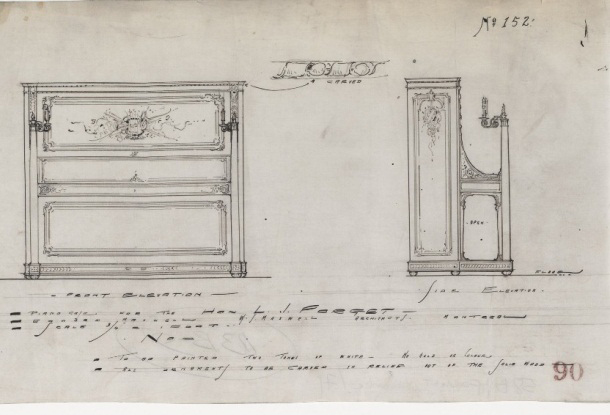
At this stage, I can only imagine that the activity intensified on the Gallery’s side as they scrambled to manage multiple streams of incoming materials from private and public sources. This type of collaboration is hugely important as there is common desire to make McGill’s rare collections better known and put them into a context instead of having them merely sit on a shelf. It was a pleasure for my colleague Jennifer Garland and I to assist the curators over this long haul of research and preparation.
You will get an idea of all of this hard work from the exhibition itself, and from the permanent product of the show – the visually appealing and informative published exhibition catalogue. It highlights and discusses all of the loaned and digitized material from McGill University, and from many other lenders across the country. Rosalind Pepall, the principal co-curator of the show, stressed the importance of maintaining this unique resource. She noted, “Thanks to the McGill Library loans, visitors from all across the country visited the National Gallery exhibition and were able to appreciate the exquisitely rendered architectural drawings that Canadian architects such as the Maxwells and Percy Nobbs were trained to do and did so well. We owe a big thank you to the McGill Library for preserving this architectural heritage not only for Montreal, but also for Quebec and for Canada.”
If you are in the Ottawa area, Artists, Architects and Artisans: Canadian Art 1890-1918 has been extended through to February 17, 2014. The exhibition printed catalogue of the same name can be consulted at any time in the collections of the McGill Library. For more information, go here.
Ann Marie Holland is a Liaison Librarian in Rare Books and Special Collections

Great article! By the way, the cover photo is from the chapel (oratory) in Davis House 3654 prom Sir-William Osler… many of the items in the exhibit were lent to the National Gallery by McGill’s School of Physical and Occupational Therapy. The Gallery wants to keep the oratory for an additional 2 years!
It makes me sad to read this splendid article now just before the show ends! I wish I would have known sooner and I would have made the trip to Ottawa to see it.
Yes I know I should have a membership in the National Gallery! I only wish I had known about this interesting exhibition sooner!